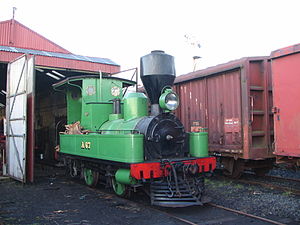- NZR A class (1873)
-
NZR A class (1873) 
A67 at Ocean Beach Railway Power type Steam Builder Dübs & Co. (12),
Yorkshire Engine Company (2)Build date 1873 (12), 1875 (2) Configuration 0-4-0T Gauge 3 ft 6 in (1,067 mm) Driver diameter 30 in (762 mm) Wheelbase 5 ft 7 in (1.70 m) Length 18 ft 0 in (5.49 m) Locomotive weight 11 long tons (11 t) Fuel type Coal Fuel capacity 0.4 long tons (0.41 t) Water capacity 330 imperial gallons (1,500 l; 400 US gal) Boiler pressure 120 psi (0.83 MPa) Firegrate area 4.2 sq ft (0.39 m2) Heating surface:
Total269 sq ft (25.0 m2) Cylinders Two, outside Cylinder size 8 × 15 in (203 × 381 mm) Tractive effort 3,072 lbf (13.7 kN) Career Public Works Department, NZGR Number in class 14 Locale New Zealand Preserved Four (62, 64, 66, 67) Disposition Four preserved, ten scrapped The A class was the second class of steam locomotive (after 1872's F class) ordered to work on New Zealand's national railways. It should not be confused with the more numerous A class 4-6-2 tender locomotives of 1906. Initially ordered by the Public Works Department for use in the construction of lines, the A class was a small tank locomotive with a wheel arrangement of 0-4-0T. An initial twelve were constructed by Dübs & Co. in 1873 and two more were built in 1875 by the Yorkshire Engine Company. They were not just used by the Public Works Department; the New Zealand Government Railways also utilised the class to operate revenue services on smaller branch lines. None existed in government service by 1905, but their small size made them perfect for use on bush tramways and small private industrial sidings. Many members of the class survived for years in private use, and although all are now retired from commercial service, four have survived to be preserved by railway enthusiasts and two of the four are currently in full operational condition. One of these preserved locomotives, A 67, was the first in a cavalcade of locomotives at the celebration of the hundredth birthday of the Dunedin Railway Station.
A batch of A class engines, with differing external details was built at Wellington's Lion Foundry, by E.W. Mills Ltd in 1873, for use on the Foxton Section.
The term "Dido", as applying to New Zealand shunting locomotives, can be traced back to the small A class. Crew members from the ship Dido, moored at Bluff Harbour, in May, 1875 were looking for a night on the town, while in port. They took a small 4-wheeled rail trolley, and taking turns, both rode and pushed the trolley into Invercargill. When the southern enginemen saw the first A class locomotive arrive for use as a shunter, the name "Dido" was given as a nickname because of its diminutive size. Today, the term "Dido" is used to describe any small shunter on the NZR network.
Preservation
Dubs A class
A62 Anawhata Museum Trust, Whangarei
A64 Plains Vintage Railway, Tinwald
A66 Waimea Plains Railway, Mandeville, Southland
A67 Ocean Beach Railway, DunedinMills A class
"Opossum" Shantytown Museum, Rutherglen
A 65 - Chassis Shantytown Museum, RutherglenExternal links
References
- Heath, Eric, and Stott, Bob; Classic Steam Locomotives Of New Zealand, Grantham House, 1993
- "A class 0-4-0T". New Zealand Railways Steam Locomotives. http://www.trainweb.org/nzsteam/a_class.html. Retrieved 2008-05-29.
Categories:- Locomotives of New Zealand
- 0-4-0T locomotives
- Dübs locomotives
- YEC locomotives
- New Zealand rail transport stubs
Wikimedia Foundation. 2010.
